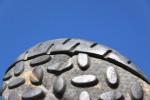Friction Rules!
 Five-Ten (5-10) Exum Guide boots are multi-purpose, and built for comfort and friction-induced traction. The Exum Guide Boots were designed by climbers and mountaineers with decades of experience and input to deliver a well built hiking boot. The Exum Guide uppers, mid-sole, and insole are the products of that long experience to keep feet comfortable in an all day trail hiking experience.
Five-Ten (5-10) Exum Guide boots are multi-purpose, and built for comfort and friction-induced traction. The Exum Guide Boots were designed by climbers and mountaineers with decades of experience and input to deliver a well built hiking boot. The Exum Guide uppers, mid-sole, and insole are the products of that long experience to keep feet comfortable in an all day trail hiking experience.
When we took delivery of a couple pair of 5-10 shoes, we knew the company was best known amongst the rock-climbing elite for many years. But what we also realized was how the Exum Guide boots, that appear so straight forward, would prove to be such solid hiking boots. These Exum Guides are not clumsy or bulky. They were worn on long road trips where driving to the destination was part-and-parcel with getting to the trailhead, and they were comfortable.
Non-sealed waterproof leather uppers of the Exum Guide are mid-high, with rough-out leather running from the front and top of the ankle area and back to the heel. Additional smooth leather runs from the lower ankle area and forward to the toe. The entire lower foot area is encased with Five-Ten’s exclusive heel-cage that is essentially a rubber shield around the leather uppers to provide additinal ankle support and stability.

There are a total of 21 eyelets on each boot that soak up the super long laces. At first, it didn’t mean much. But as the Exum was worn daily over many weeks on the street and on the trail, it became evident that the density of the boot laces secured the Exum around the feet all day, in comfort. Lacing eyelets in the well padded boot tongue keep it in place, providing a nice cushion for the front and top of the foot.
As a result of this simple and straight forward lacing system, the Exum’s rarely needed retying or adjustment. Once they were laced up in the morning, they were good to go for hours. The small size of the actual metal eyelets did pose a challenge with re-lacing the shoes. Larger eyelets would make changing out a pair of boot laces much easier. Although the laces that come with the Exum Guides held up very well.
Used as approach shoes or for day hikes into the snow fields, the Exum Guides are compatible with crampons. These shoes are not insulated for warmth, but they are waterproof and built for day sessions practicing with the ice-ax, and rope-work.

An illuminating coating on the raised logos on the outer sides of each Exum makes them stand out in a beam from a headlamp when you’re trying to find your boots in the dark. That’s a nice touch, but the illuminating material does tend to wear off. The wear does not eliminate the “Glow In the Dark” material altogether as the boots can still be easily seen in the headlights of vehicles if you’re wearing these boots on the street or riding your mountain bike at night.
Although the insole is generally comfortable, the Exum is very compatible with gel-inserts if your feet are flat or need the extra cushion. The Exum has the right amount of outsole firmness to support crampons, and provide a traction platform for push-offs on rock surfaces. They have good flexibility for long, swift, day hikes where you’ll appreciate the lightweight and snug fit.
Sizing of the Exum was exactly as ordered. Break in time, in our case, was not a factor. There were no issues with blisters or foot discomfort associated with the Exum’s design due to rubbing at the heel or top-rear of the uppers against the lower calf muscles.
The Exum Guide boots we reviewed weren’t put to extreme rock-clinging examinations, they were worn often and they were worn for many miles on trail hikes and running amok on city streets. The Stealth tread pattern design is continuous from heel to toe with a cross-pattern of oval cleats positioned in overlapping angles to provide traction points. Firm push-off pads at the toe and outer sides of the foot and inside of the heel provide a sturdy base.

Push-off sections at the toe of the Stealth soles provide an extended, slightly back-cut, edge to grab and hold onto a surface. The rubber compound for the soles on the Exum Guide boots are designed to provide shock absorption and the friction needed to keep your boot bottoms in contact with the rock and trail surfaces you are likely to experience in climb approaches and on hiking trails. The Stealth rubber compound is a little more general purpose than a dedicated rock climbing shoe, but sound traction characteristics are evident in the Exum.
Exum Guides do great with an overnight backpack or day-long hike with enough gear and water to get you to your destination, and back. Exum Guide boots are not intended to be a multi-day, heavy pack-weight type of boot. Yet, since every person is different, this observation is subjective and definitely not a critique. If you plan on wearing a boot intended for day hikes on a long backpack trip, you will definitely draw your own conclusions. The 5-10 Exum Guide boots are priced at $129.95 MSRP.
ABOUT STEALTH RUBBER

From its early beginning in the 1980’s, 5-10 footwear started with the outsole rubber compound, and built the uppers to compliment and offer long wearing durability. It is that fine line between the traction afforded by a climbing shoe or boot outsole and the physical weight of the climber that determines adhesion with the surface. And at what point would the rubber outsole compound give way to gravity and lose traction?
With an engineering degree, a passion for climbing new routes up sheer rock faces, and an incident that pushed the fulcrum point between friction induced traction, and a free fall, the driving force behind 5-10, Charles Cole, sought answers. Cole tested compounds. He worked at mathematical equations involving physics, current technologies and best practices for putting the rubber on the rock whilst keeping it there long enough for the climber to secure another foothold, another handhold.
Cole’s ultimate rubber compound formulas are used in all of 5-10’s shoe applications. And, with so many outdoor shoes that cannot be resoled, 5-10’s are resolable and resole kits are available. This capacity to design solid outdoor shoe and boots built to endure several years of hiking and climbing along with the ability to resole makes 5-10 Exum Guide boots well worth your consideration to own a pair.
By Rick Shandley


Nice post — this really hits home for me.
freshairjunkie.com – one of my favorites!!!